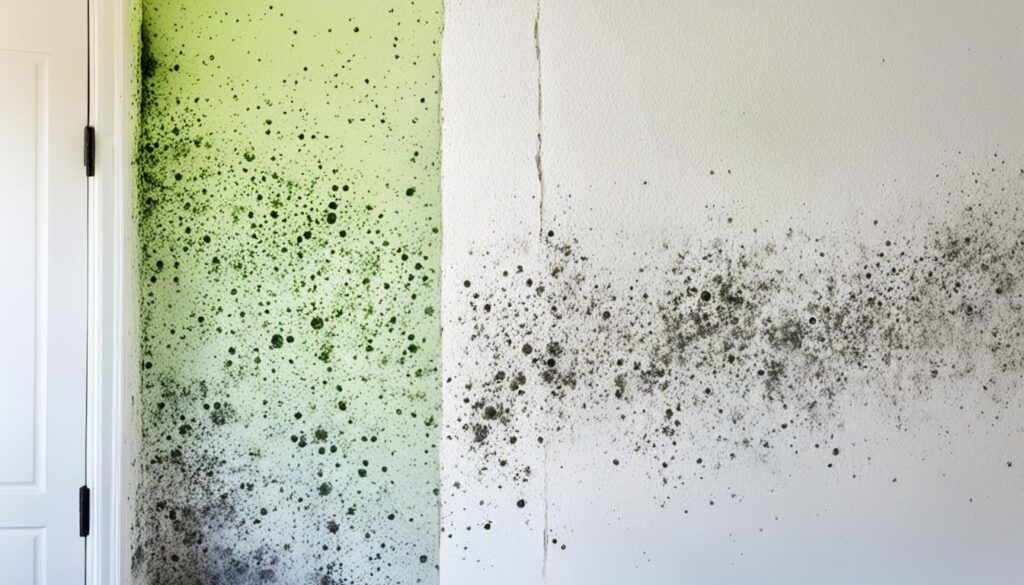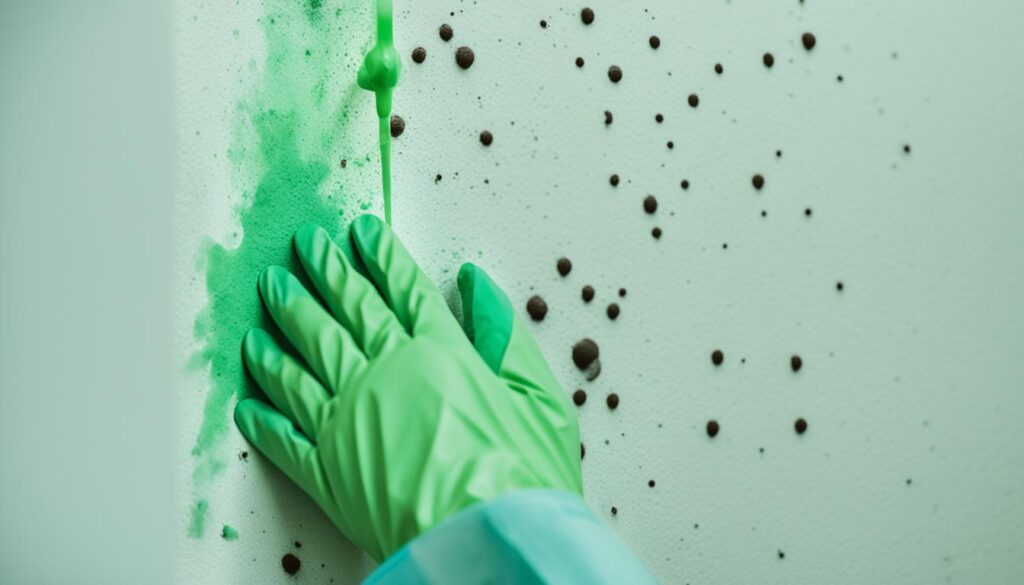
Mold Remediation: Get Rid of Mold in Your Home
Welcome to our comprehensive guide on mold remediation! If you’ve been dealing with mold issues in your home, you’ve come to the right place. In this section, we will discuss effective strategies for mold remediation so that you can rid your home of this pesky problem and create a healthier living environment.
Mold can be a persistent and harmful presence in any household. It not only ruins the aesthetic appeal of your home but also poses a threat to your health and well-being. That’s why it’s crucial to address mold issues promptly and efficiently.
Whether it’s black mold, mildew, or any other type of mold, our guide will provide you with the information you need to combat it effectively. From understanding the dangers of mold to implementing various removal techniques, we’ve got you covered.
Stay tuned for the following sections where we’ll explore the potential health risks associated with mold exposure and dive into the specifics of safe and effective mold removal methods. By the end of this guide, you’ll be armed with the knowledge to tackle mold and create a mold-free environment for you and your loved ones.
Key Takeaways:
- Mold remediation is crucial for creating a healthy living environment.
- Mold can pose significant health risks.
- Effective mold removal techniques are essential to prevent recurrence.
- Quickly addressing mold issues can save you from further damage and expenses.
- Professional mold assessment and remediation services can provide expert help.
Understanding the Dangers of Mold
Before we delve into mold removal techniques, it is important to understand the potential dangers associated with mold. Mold can pose serious health risks and lead to mold-related illnesses if not addressed promptly.
The Health Risks of Mold Exposure
Exposure to mold can trigger various health issues, especially for individuals with pre-existing respiratory conditions or weakened immune systems. The following are some common health risks associated with mold:
- Allergic Reactions: Mold spores can cause allergic reactions in sensitive individuals, leading to symptoms such as sneezing, coughing, itchy eyes, and skin rashes.
- Asthma Exacerbation: For people with asthma, mold exposure can worsen their symptoms and trigger asthma attacks.
- Respiratory Infections: Exposure to certain types of mold can increase the risk of respiratory infections, including bronchitis and pneumonia.
- Chronic Sinusitis: Prolonged mold exposure can contribute to chronic sinusitis, causing persistent inflammation and nasal congestion.
The Link Between Mold and Illnesses
Research has shown that mold exposure can be linked to a variety of illnesses. These mold-related illnesses may include:
- Mold-Induced Hypersensitivity Pneumonitis: An inflammatory lung disease that can result from inhaling mold spores.
- Mold-Induced Asthma: Long-term mold exposure may lead to the development of asthma in individuals who were not previously asthmatic.
- Mold-Associated Invasive Infections: Although rare, certain mold species can cause invasive infections in individuals with compromised immune systems, such as those undergoing chemotherapy or organ transplant recipients.
It is important to note that the severity of health risks can vary depending on factors such as the type and concentration of mold present, the duration of exposure, and an individual’s overall health. However, any presence of mold should be taken seriously to mitigate potential health hazards.
“Mold can pose serious health risks and lead to mold-related illnesses if not addressed promptly.”
To visually illustrate the dangers of mold, refer to the image below:

Effective Mold Removal Techniques
In this section, we will explore different techniques for removing mold from your home. Whether you prefer a do-it-yourself approach or seek professional assistance, there are effective methods available to eliminate mold and ensure a safe living environment.
Mold Removal Methods
When it comes to removing mold, it’s essential to choose the right method based on the severity of the infestation and the affected surface. Here are a few common mold removal methods:
- Bleach Solution: Diluting bleach with water can be effective for removing mold from hard, non-porous surfaces. Remember to wear protective gear and ensure proper ventilation when using bleach.
- Vinegar: Vinegar is a natural alternative to bleach for mold removal. Its acidic properties make it effective against mold on various surfaces. Combine vinegar with water in a spray bottle and apply directly to the affected area.
- Hydrogen Peroxide: Hydrogen peroxide is another chemical solution that can kill mold effectively. Apply it directly to the mold-infested surface, let it sit for 10 minutes, and then scrub away the mold with a brush.
- Commercial Mold Removal Products: There are numerous mold removal products available on the market that are specifically formulated to tackle mold infestations. Follow the manufacturer’s instructions for safe and effective use.
Safe Mold Removal Practices
Regardless of the mold removal method you choose, it’s crucial to prioritize safety throughout the process. Here are some essential steps to follow:
- Wear protective clothing, including gloves, goggles, and a mask, to prevent exposure to mold and its spores.
- Ensure proper ventilation by opening windows and using fans to improve air circulation.
- Contain the mold-infested area by sealing off nearby vents and doors to prevent the spread of spores to other parts of your home.
- Properly dispose of mold-contaminated materials in sealed bags to prevent further contamination.
- Thoroughly clean and dry the affected area after removing the mold to prevent its recurrence.
Mold Prevention
Preventing mold growth is the key to maintaining a mold-free home. Here are some preventive measures you can take:
- Maintain proper ventilation: Ensure good airflow by using exhaust fans in bathrooms and kitchens. Additionally, opening windows regularly can promote air circulation and prevent excess moisture.
- Control humidity: Keep indoor humidity levels below 50% to discourage mold growth. Use dehumidifiers or air conditioners in humid areas if necessary.
- Address water leaks promptly: Repair any leaks in plumbing, roofs, or windows immediately to prevent the accumulation of moisture, which can lead to mold growth.
- Proper insulation: Insulate your home properly to prevent condensation on cold surfaces, as this can create favorable conditions for mold growth.
- Regular cleaning: Regularly clean and dry areas prone to moisture, such as bathrooms, basements, and kitchens, to prevent mold colonization.

By implementing effective mold removal techniques and practicing mold prevention strategies, you can create a healthier living environment for you and your family.
Conclusion
In conclusion, mold remediation is essential for creating and maintaining a healthy home environment. Mold can pose significant health risks and lead to various illnesses, making it crucial to address mold issues promptly. By understanding the dangers of mold and implementing effective removal techniques, you can achieve a mold-free space and safeguard the well-being of you and your family.
If you’re facing a mold problem that exceeds your capabilities, it’s important to seek professional help. Fix Mold Miami is a trusted mold assessment and remediation service provider with expertise in handling mold issues effectively. Their skilled team is equipped to assess the extent of mold damage, implement safe and efficient removal methods, and help prevent mold recurrence in your home.
Contact Fix Mold Miami today at 305-465-6653 to schedule a professional mold assessment and remediation service. Don’t compromise on your family’s health and safety when it comes to mold. Take action now and create a safer living environment for a healthier future.




